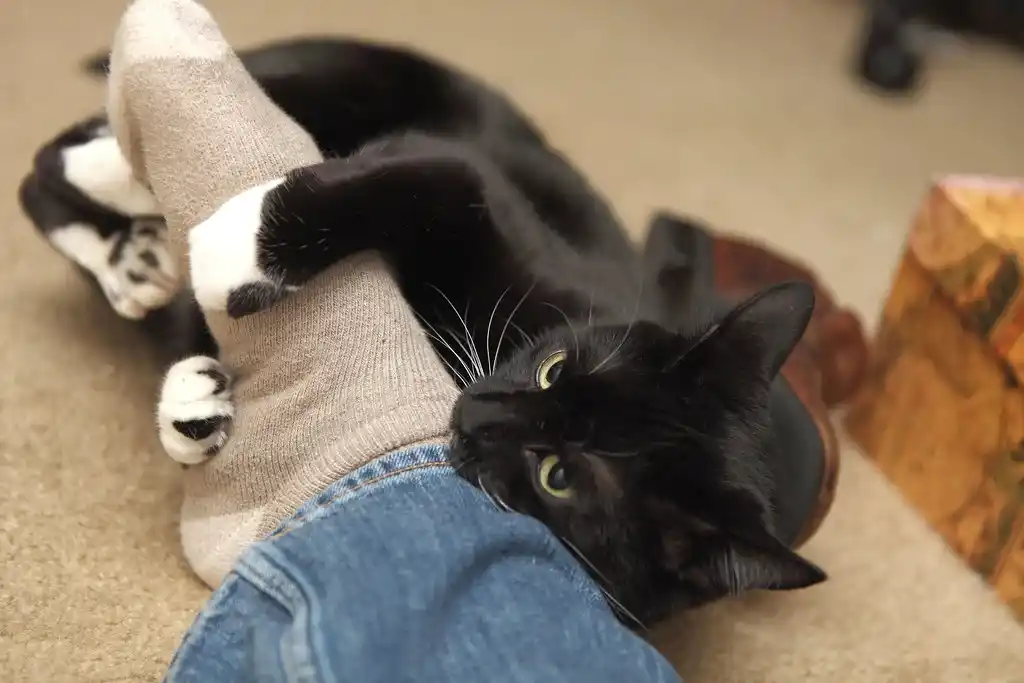Why Does My Cat Randomly Attack and Bite Me ?
You’re not alone to face the problem that your Cat Randomly Attack and Bite you. if you’ve ever been relaxing on your sofa and then been shocked by your cat jumping and biting you. Many cat owners wonder why these seeming random attacks happen. Your cat’s wellbeing as well as your own depend on knowing why it could attack and bite you. This article aims to give thorough understanding of this confusing behaviour thus enabling new owners of kittens to deal with these difficulties.
Understanding Cat Aggression
Cats may act aggressively for a number of reasons. These bites can appear to strike out of nowhere, confusing and alarming you. Knowing the fundamental reasons will enable you to control and lessen these events.
Play Aggression
Play rudeness is among the most often occurring causes of unexpected biting. Naturally curious, kittens and young cats play by pouncing, biting, and clawing. Given earlier encouragement of this behavior, they might see your hands or feet as toys.
When my kitty, looked great playing with my fingers when I first received him. I had no idea, however, I was preparing the ground for next biting incidents.
Fear or Anxiety
Cats are sensitive animals, hence sudden shifts in their surroundings or schedule may cause worry or panic which results in violent behavior. Should your cat sense danger, they may act in defense by lashing out. Typical triggers include loud sounds, strange persons or animals, or even everyday routine disruptions.
Cat Biting Habits
Overstimulation
Cats have a limit on the amount of touching or caressing they can bear. A cat experiencing overstimulation has had enough interaction and wants a rest. Overstimulation shows itself as flattened ears, twitching tail, and dilated pupils. Should you touch your cat beyond this point, they may bite to indicate they have had enough.
Redirected Aggression
When a cat is irritated by something they can’t play with, like a bird outside the window, they aim their fury on the closest target—you.
I once experienced this when Luna saw a stray cat through the window. Unable to reach the other cat, she turned and bit my leg instead. It was a startling lesson in understanding redirected aggression.
Understanding Cat Behavior
Body Language Before an Attack
Reading your cat’s body language can help you anticipate and prevent biting incidents. Key signs to watch for include:
-
- Tail Twitching: Indicates agitation or excitement.
- Ears Flattened: Sign of fear or aggression.
- Dilated Pupils: Can indicate excitement or fear.
- Hissing or Growling: Clear signs of aggression and a warning to back off.
Common Triggers
Identifying what triggers your cat’s aggression is crucial. Common triggers include:
-
- Physical pain: Should an accident or sickness cause your cat in pain, they may bite when touched.
- Territoriality: Cats are territorial creatures that may bite to defend their territory against seen attackers.
- Lack of Socialization: Cats that have not had appropriate socialization may not know how to gently interact with people.
How to Manage and Prevent Cat Biting
Creating a Safe Environment
Giving your cat a secure and stress-free surroundings can help to lower her chances of aggressive behavior. Make sure your cat has toys to keep it occupied and comfortable as well as lots of hiding places and climbing platforms.
Proper Socialization
Early socializing of your cat enables them learn acceptable behavior. Gradually expose them to many people, animals, and surroundings to boost their confidence and lower anxiety-driven aggressiveness.
Playtime and Stimulation
Regular play with suitable toys can allow your cat to focus their natural hunting impulses away from your hands and feet. Excellent for this are toys that resemble prey, such laser pointers and feather wands.
Handling Overstimulation
Understanding the signs of overstimulation and honoring your cat’s limits can help to stop biting events. If you see symptoms of overstimulation, give your cat room and let them approach you for interaction when they’re ready.
Addressing Behavioral Issues
Training Techniques
Positive reinforcement training may assist to change your cat’s behavior. Treats or love for rewarding positive behavior helps your cat to keep on doing those acts. Steer clear of punishment as it fuels anxiety and hostility.
Consulting a Veterinarian
See a veterinarian should your cat’s violent behavior continue or become worse. A medical issue that is producing pain or discomfort has to be taken care of. Should necessary, a veterinarian may also suggest behaviorists or specific training.
Personal Experiences and Anecdotes
Personal experiences help the material to be more interesting and relevant. My cat would bite my fingers regularly during play when she was a kitten. She grew, and her bites started to hurt. At first, I assumed it was simply harmless activity. Through research and observing her behavior, I learned about play aggression and redirected her energy towards toys instead. This simple change made a significant difference in our interactions.
References
For more insights into cat behavior, check out these related articles:
How to Stop Kitten Biting and Scratching | 7 easiest ways
Why Do Cats Bring You Their Kittens? Understanding Feline Love
I consulted dependable and authoritative sources such the American Veterinary Medical Association (AVMA) and respectable pet care websites in order to provide correct and consistent knowledge. The AVMA claims that knowing feline behavior and creating an interesting surroundings would help to greatly lower aggressive behavior in cats.
Have you experienced your cat randomly attacking and biting you? Share your tips and experiences in the comments below! For more tips on kitten care and behavior, check out our other articles and stay connected for the latest updates.
Conclusion
Managing and stopping your cat’s random attacking and biting of you starts with knowing why it could do so. You may build a good and peaceful connection with your feline buddy by spotting aggressive behavior, creating a safe and interesting surroundings, and using positive reinforcement training. Remember that treating behavioral problems and maintaining your cat feels safe and loved depend mostly on consistency and patience.

